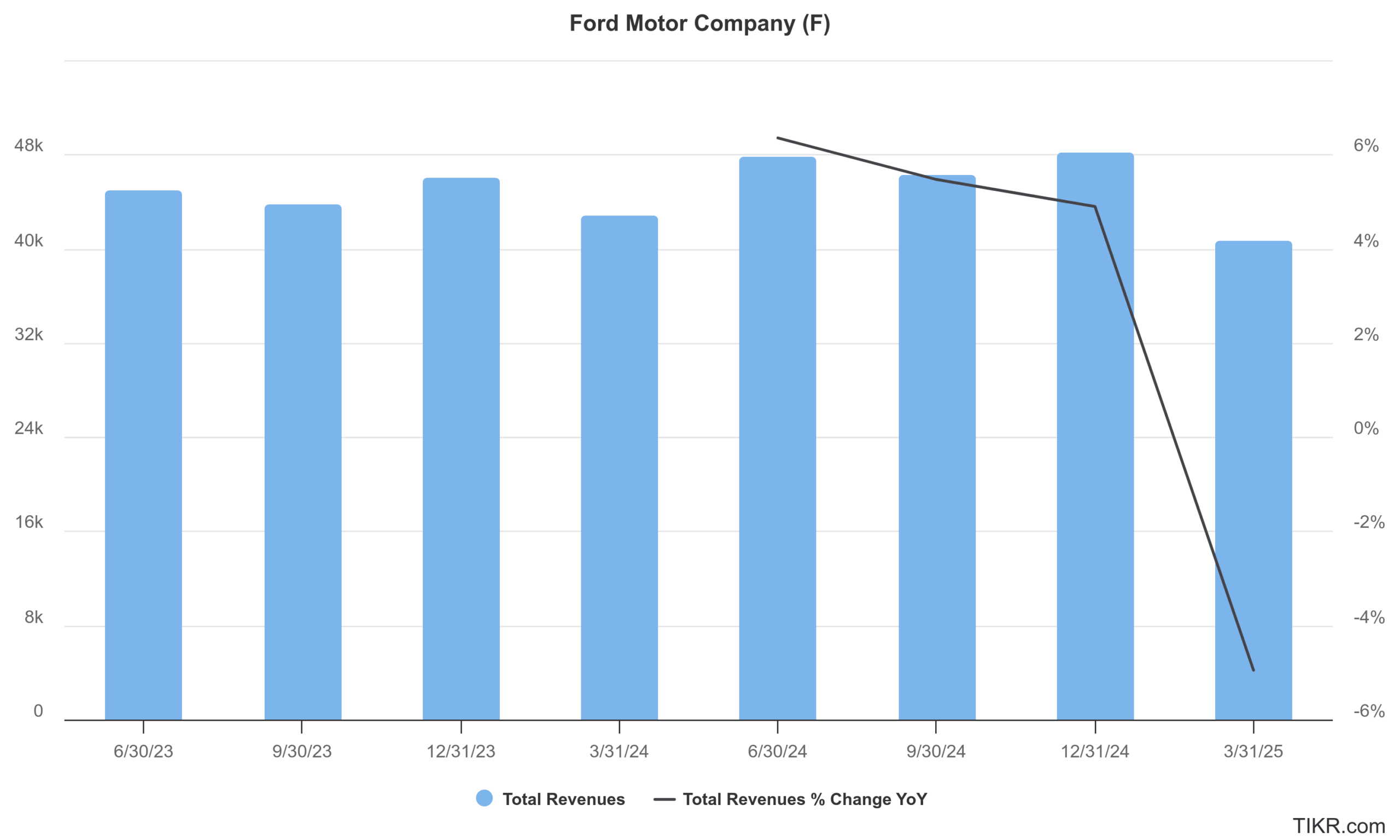Ford Stock Rises After Company Reports Sharp Rise in May Sales
Please note that we are not authorised to provide any investment advice. The content on this page is for information purposes only.
Ford stock (NYSE: F) is trading higher today after the company reported a 16% YoY rise in its May US auto sales. The steep rise, which marks the third consecutive month of double-digit gains, comes amid President Trump’s tariffs, which have pushed up prices for vehicles.
Ford sold 220,959 units in May in the US as compared to 190,014 units in May 2024. The sharp rise was led by sales of internal combustion engine vehicles, whose sales rose 17.2% to 191,517 units, showcasing the continued demand for traditional gasoline-powered vehicles.
Ford Is Offering Employee Pricing On Some Models
Sales of Ford’s trucks rose 11.2% to 121,354 units. The iconic F-Series trucks were a major driver, with sales climbing 17.7% to 77,915 units. SUV sales were quite strong too and rose 25% to 94,595 units. Ford Bronco (up 51.1%), Bronco Sport (up 45.7%), Expedition (up 43.2%), and Explorer (up 22.6%) were the key drivers of the surge in SUV sales.
The steep rise in sales came amid the employee pricing that Ford is providing on many of its models. President Trump has imposed a 25% tariff on imports of cars and some car parts, which has increased costs for automakers. However, companies have been looking at ways to offset the costs through increased localization and increased production at their US plants. Moreover, to blunt the impact of these tariffs on customers, they are offering discounts.
Ford Reported a Fall in EV Sales
Ford’s electric vehicle (EV) sales declined by 25% to 6,723 units last month, largely due to a significant drop in F-150 Lightning and E-Transit sales. However, sales of the Mustang Mach-E rose 11% during the month.
Amid slowing sales of battery electric vehicles, Ford has doubled down on hybrids. The company reported sales of 22,719 units for the category, which is 28.9% higher YoY. Ford plans to launch hybrid models across all its products by the end of this decade. While hybrids were an overlooked segment for automakers, with only Toyota focusing on them, over the last couple of years, automakers like Ford and General Motors (NYSE: GM) have also doubled down on hybrids amid slower-than-expected sales of all-electric models.
The EV and hybrid segment form part of Ford’s Model e segment. Last year, the segment posted a pre-tax loss of $5.08 billion, and during the Q4 2024 earnings call earlier this year, Ford said that it expects the segment’s losses to be between $5 billion-$5.5 billion this year. Notably, both Ford and General Motors are struggling with profitability in their EV business, in part due to the price war, which has depressed the pricing.
Model e posted a loss of $849 million compared to $1.33 billion in the corresponding quarter last year.
Ford Suspended Its 2025 Guidance
Ford’s total revenues fell 5% YoY to $40.7 billion in Q1 2025. The company’s automotive revenues came in at $37.42 billion, which was ahead of the $36.21 billion that analysts were expecting. The company generated a net income of $0.5 billion, and its EPS of 14 cents easily surpassed the 2 cents that analysts were expecting.
Ford withdrew its 2025 guidance amid the uncertainty over tariffs. Meanwhile, Ford said that if not for the tariffs, it was on track to meet its 2025 guidance of adjusted pre-tax earnings between $7 billion-$8.5 billion.
General Motors also held back its 2025 guidance during the Q1 earnings release. However, it later warned of a hit of between $4 billion-$5billion from the tariffs and lowered its adjusted pre-tax earnings guidance to between $10 billion and $12.5 billion, versus the previous guidance of between $13.7 billion and $15.7 billion.
Similarly, it cut the adjusted automotive free cash flow to between $7.5 billion and $10 billion, compared to the previous guidance of between $11 billion and $13 billion.
US Automotive Industry Battles Tariff Uncertainty
The automotive industry in North America is quite integrated, and the tariffs are disruptive for US auto majors. Notably, Canada, Mexico, and the US were covered under the NAFTA (North American Free Trade Agreement), which Trump renegotiated in his first tenure. In July 2020, the USMCA (United States-Mexico-Canada Agreement) replaced NAFTA, which had come into effect in 1994. The USMCA is also scheduled for a review in July 2026.
For years, the US automotive industry benefited from lower production costs in Mexico, and global auto giants set up plants in that country. The tariffs are, however, set to negatively impact companies like Ford, General Motors, and Volkswagen as they all have manufacturing footprints in Mexico and Canada.
Trump’s Steel and Aluminum Tariffs to Hit US Automakers
President Donald Trump doubled the tariffs on steel and aluminum to 50%. The tariffs are set to come into effect from today and are expected to push up prices in the US, thereby raising input costs for automakers.
The President made the announcement at a U.S. Steel Corporation facility in Pennsylvania that he visited after approving the company’s acquisition by Japan’s Nippon Steel, which he had previously opposed. Along with raising steel and aluminum costs for US industry, the massive tariffs might also lead to an escalation in the trade war, particularly with the EU.
While no automaker has yet issued a profit warning on the impact of these tariffs, in 2018, Ford had warned of a hit of $1 billion between 2018 and 2019 from the steel and aluminum tariffs that Trump had imposed in his first tenure. Notably, back then, Trump slapped a 25% tariff on steel imports and a 10% tariff on aluminum imports. This time, he started with a 25% tariff on both metals, which he is now raising to 50%.
Meanwhile, Ford stock is trading higher after having fallen below $10 yesterday amid fears over Trump’s steel tariffs. The stock is up over 5% for the year and is outperforming the S&P 500 Index.






